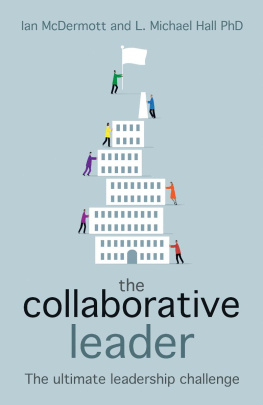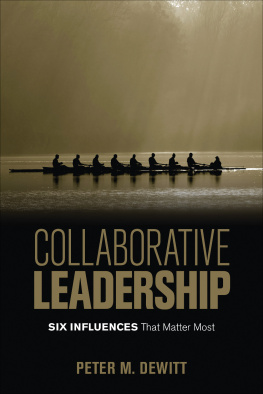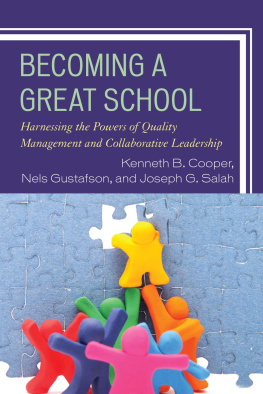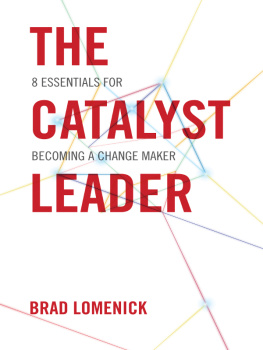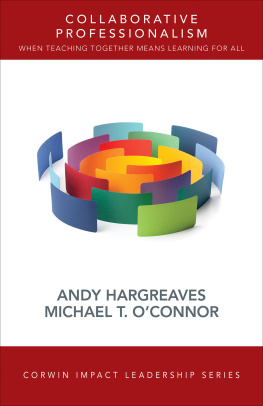Praise for The Collaborative Leader
The benefits of collaboration to leaders in the private, public and voluntary sectors are beyond doubt. In this world of increasing complexity, leaders are frequently required to work across conventional boundaries to achieve their objectives. This almost inevitably requires leaders to have the capability to collaborate effectively. In this work McDermott and Hall set out to demystify the art of collaboration and provide a methodology for leaders to achieve excellence in its application. The book also addresses the negative side of failed collaborative ventures and analyzes the principle causes. A must-read for aspiring leaders and everyone grappling with complex change.
Martin Roberts PhD, author of Change Management Excellence
In business, collaborative leadership is becoming an essential skill and principle and yet it is often misunderstood, with frustrating results. In The Collaborative Leader, the authors give you plenty of thought-provoking questions, examples and models to help you walk the sometimes less than easy path of true collaboration.
Joe Cheal, leadership development specialist and author
Ian and Michael have been great thinkers and creators of quality information for the field of NLP for many years and their latest effort is certainly something special. Collaborative leadership, for most writers, is like trying to organize smoke. Ian and Michael have managed to be systematic, carefully specific (where most have failed), and even pragmatic in this effort to help us all understand, and actually learn how to use, the wonderful and valuable systems of collaboration. I really appreciate their careful explanation that leaders must make sure that their own preconceptions and habits are fully understood and sometimes changed. So, here we have critically important skill sets, presented at the right time in our ongoing effort to help organizations and teams move toward excellence. They have professionally identified principles and skills in a way that is pragmatic enough to be incredibly useful. Right information, right time, right presenters. It doesnt get better. Get the book and find out for yourself what a sterling job these two men have done, again.
R. Frank Pucelik, Pucelik Consulting Group, INLPTA, and ANLP
Contents
Behind all the current buzz about collaboration is a discipline. And with all due respect to the ancient arts of governing and diplomacy, the more recent art of collaboration does represent something newmaybe Copernican. If it contained a silicon chip, wed all be excited.
John Gardner
Creative collaboration is now possible on an unprecedented scale, by people based all over the world.
Warren Bennis, On Becoming a Leader (2003)
Collaboration is co-laboring, literally laboring with others. Given this, it is only natural that a book on collaboration should be written collaboratively by more than one author. Thats precisely what we have done in this book.
Both of us have engaged in many collaborations over the years and we ascribe much of our personal success to working with otherscollaborating. We are also both seasoned writers as well as leaders in our own areas. Did we have time to collaborate and write another book? No, but we made time because this really matters to us, which is true of many collaborations.
When we began there was another person involved in this projectShelle Rose Charvet. Actually, she was the one who originally brought us together and the three of us worked on this project jointly. But then life happens and Shelle realized she had taken on too much and needed to focus on her new business. She said that for my own well-being I need to cut back on my commitments. So she chose to step out of the project. This made us aware of an important aspect of collaboration: Collaborations inevitably grow, change, and evolve as people, situations, and needs shift over time.
As our experience with Shelle makes clear, collaboration is a rich and dynamic process between people; it is a living, evolving experience. It is not a rigid set of roles or rules about how to do something. It is an act and experience of creativity wherein a few, or many, people discover how to interact in such a way that new emergent ideas arise; ideas which, when put into action, can bring forth new and wonderful innovations.
Can You Give Me the TED Version of This Book?
While we identified a great many facets of collaboration in our initial inquiry phase, when we began writing this book, we shifted our focus to a singular question: What do we feel passionate about regarding collaboration that would make this book unique and transformative for the lives of those who read it?
In this book we have answered that question by focusing on three main considerations about collaboration and leadership:
- What is collaboration?
- How does it relate to leadership?
- How do you do it effectively?
First, what is collaboration? Collaboration is the demanding business of working together to get things done in order to get practical results. It builds businesses, makes money, and launches pragmatic solutions into the world. As we show you how this works, you will see how it can give you an edge in your leadership.
Second, how does collaboration relate to leadership? Collaboration requires leadership. It needs a person (or team) to bring people together and enable them to work effectively as one. Inspiring and administrating a collaborative partnership brings out the best in them. As we explain how to do this, you will learn lots of collaborative leadership skills.
Third, how do you do collaboration effectively? Collaboration necessitates skills. It requires a set of core competencies that enable people to work together effectively to achieve what none could accomplish alone or apart. As you develop these qualities, you will take your leadership skills to a whole new level.
We have found that there are many misconceptions about collaboration. One of the most common is that collaboration is a nice idea about people getting along and feeling good about each other, but it doesnt improve the bottom line. Another myth is that collaboration requires a mediator, not a leader, because it involves getting people to compromise. There are many more. Such myths obscure the fact that collaboration actually gives businesses a competitive advantage and can deliver a real return on investment. All truly great organizations are great because of collaboration. We call these misconceptions collaboration myths.
Our contention is that a great deal of collaboration is hidden in plain sight and its importance is often unrecognized and unappreciated. Without some degree of implicit collaboration, its almost impossible to get much done at all. We believe this has huge implications for anyone in leadership. As you will discover, the fact is that collaboration involves a set of core competencies that are, in effect, leadership competencies. These can be learned and improved.
This also highlights another hidden truth: The ability to collaborate is the ultimate leadership skill. And thats what our world is increasingly demandingcollaborative leaders. Therefore, promoting collaboration as a skill set is the next great step in leadership development. So, we have written this book to make explicit what collaborative leadership is and how to become that kind and quality of leader.
What Will You Get From This Book?
There are many benefits to be gained. First of all, a practical approach to developing high level collaboration skills. Instead of focusing on the theories behind collaboration, we have designed The Collaborative Leader

